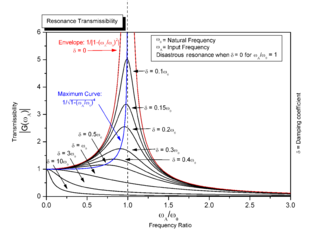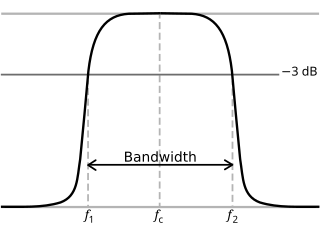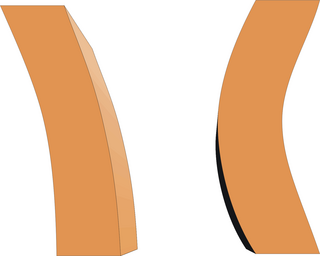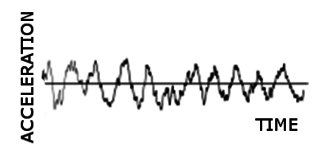The Extreme Response Spectrum (ERS) (or Maximum Response Spectrum (MRS)) is defined as a curve giving the value of the highest peak of the response of a linear Single Degree of Freedom System (SDOF system) to vibration, according to its natural frequency, for a given damping ratio. The response is described here by the relative movement of the mass of this system in relation to its support. The x-axis refers to the natural frequency and the y-axis to the highest peak multiplied by the square of the quantity (2 π x natural frequency), by analogy with the relative displacement shock response spectrum.

The fundamental frequency, often referred to simply as the fundamental, is defined as the lowest frequency of a periodic waveform. In music, the fundamental is the musical pitch of a note that is perceived as the lowest partial present. In terms of a superposition of sinusoids, the fundamental frequency is the lowest frequency sinusoidal in the sum. In some contexts, the fundamental is usually abbreviated as f0, indicating the lowest frequency counting from zero. In other contexts, it is more common to abbreviate it as f1, the first harmonic.
Since the fundamental is the lowest frequency and is also perceived as the loudest, the ear identifies it as the specific pitch of the musical tone [harmonic spectrum]....The individual partials are not heard separately but are blended together by the ear into a single tone.
Damping is an influence within or upon an oscillatory system that has the effect of reducing, restricting or preventing its oscillations. In physical systems, damping is produced by processes that dissipate the energy stored in the oscillation. Examples include viscous drag in mechanical systems, resistance in electronic oscillators, and absorption and scattering of light in optical oscillators. Damping not based on energy loss can be important in other oscillating systems such as those that occur in biological systems and bikes.
Kinematics is a branch of classical mechanics that describes the motion of points, bodies (objects), and systems of bodies without considering the forces that caused the motion. Kinematics, as a field of study, is often referred to as the "geometry of motion" and is occasionally seen as a branch of mathematics. A kinematics problem begins by describing the geometry of the system and declaring the initial conditions of any known values of position, velocity and/or acceleration of points within the system. Then, using arguments from geometry, the position, velocity and acceleration of any unknown parts of the system can be determined. The study of how forces act on bodies falls within kinetics, not kinematics. For further details, see analytical dynamics.
The severity of a vibration can be evaluated by calculating the stresses on a mathematical or finite element model of the structure and, for example, comparison with the ultimate stress of the material. This is the method used to dimension the structure. Generally, however, the problem is instead to evaluate the relative severity of several vibrations (vibrations measured in the real environment, measured vibrations with respect to standards, establishment of a specification etc.). This comparison would be difficult to carry out if one used a fine model of the structure and besides, this is not always available, in particular at the stage of the development of the specification of dimensioning.
A solution consists of applying the vibration under consideration to a “standard” mechanical system, which thus does not claim to be a model of the real structure, composed of a support and N linear one-degree-of-freedom resonators, each one comprising a mass, a spring and a damping device.
A vibration A is considered as more severe than a vibration B if it produces a highest relative displacement (i.e. a highest stress) on this SDOF system than the vibration B.
An ERS is generated from a vibration signal using the following process:
1. Choose a damping ratio for the ERS to be based on;
2. Assume a hypothetical Single Degree of Freedom System, with a given natural frequency (Hz);
3. Calculate (by time base simulation or from a Power Spectral Density (PSD) of the vibratory signal) the highest instantaneous relative displacement experienced by the mass element of this SDOFs at any time during exposure to the vibration in question. Plot this value multiplied by the square of (2 π x natural frequency) against the natural frequency of the hypothetical system;
4. Repeat steps 2 and 3 for other values of the natural frequency.
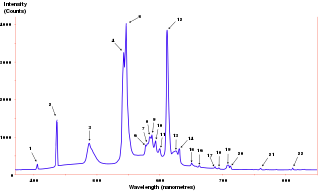
The power spectrum of a time series describes the distribution of power into frequency components composing that signal. According to Fourier analysis, any physical signal can be decomposed into a number of discrete frequencies, or a spectrum of frequencies over a continuous range. The statistical average of a certain signal or sort of signal as analyzed in terms of its frequency content, is called its spectrum.
The resulting plot is called an Extreme response spectrum .

A response spectrum is a plot of the peak or steady-state response of a series of oscillators of varying natural frequency, that are forced into motion by the same base vibration or shock. The resulting plot can then be used to pick off the response of any linear system, given its natural frequency of oscillation. One such use is in assessing the peak response of buildings to earthquakes. The science of strong ground motion may use some values from the ground response spectrum for correlation with seismic damage.
